The best-performing marketers aren’t guessing.
They’re using cold, hard data to shape what they create, how they optimize, and where they focus.
In this article, we’ve pulled together the most meaningful SEO stats from across the web, so you can cut through the noise and make decisions based on facts, not gut feel.
How does your website score? Get a free instant audit that will uncover the biggest SEO issues affecting your site, and how to fix them.
Article Summary
- SEO remains essential as search continues to evolve with AI, chat, and visual platforms
- Relying on data, not guesswork, gives marketers a competitive edge in strategy and execution
- High-ranking content still follows key fundamentals like keyword placement, structure, and relevance
- Meta tags, headings, and formatting help Google understand and surface your content more effectively
- Long-form, well-organized content signals expertise and earns better visibility
- Zero-click search features are rising, so winning SERP features is just as important as ranking
- AI Overviews, snippets, and interactive SERPs are reshaping how users interact with search results
- To stay ahead, optimize for both human readers and machine interpretation across formats and features
Why SEO Statistics Still Matter in 2025
- Google processes over 8.5 billion searches every day (Statista).
- Roughly 79% of internet users use search engines regularly (Statcounter).
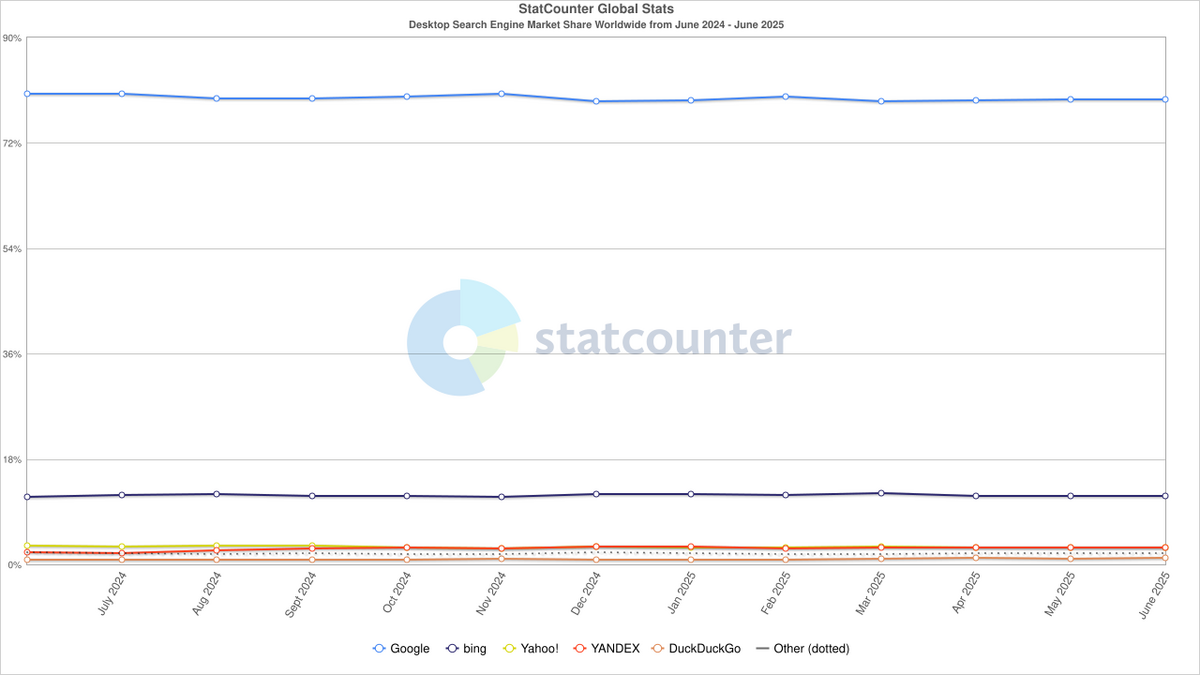
Source: Statcounter
This massive search volume makes one thing clear: Understanding user behavior is essential.
Casual guesses won’t cut it.
- In fact, HubSpot reports that using data to guide strategy was one of the top changes in 2024, reinforcing that SEO decisions should be based on evidence, not assumptions (Hubspot).
- Google continues to dominate the search landscape. It handles 78% of all online queries, meaning nearly every consumer starts their journey with a search(Smartinsights).
That kind of market share makes SEO non-negotiable.
Ignoring it means ignoring most of your potential audience.
Surveys back up this emphasis on data:
- About 30.55% of marketers say analytics guide their best strategies (Hubspot).
- 87% admit data is their most underused asset (Invoca).
That gap shows just how many teams aren’t fully leveraging their SEO analytics, and just how much opportunity exists for those who do.
These insights matter even more as search rapidly evolves.
With new technologies like AI chatbots and visual search changing the rules, staying current with fresh data is key.
By grounding your Search Engine Optimization (SEO) in real-world statistics, your strategy needs to stay aligned with user behavior, and ahead of Google’s shifting algorithms.
Key Google Ranking Statistics
Why Ranking on Page One of Google Still Matters
- Seventy-five percent of Google users never scroll past the first page of results, so if you’re not on page one, you’re invisible to most searchers (Hubspot).
That top spot isn’t just a vanity metric. It directly correlates with traffic, clicks, and visibility, making organic placement more valuable than ever.
What is the average CTR for position 1 on Google?
- The average click-through rate (CTR) for position #1 on Google is 39.8%, making it the most dominant real estate in the search engine results page, the second position sees just 18.7% of clicks, while the third result gets around 10.2% (Firstpagesage).
That means the top 3 organic search results collectively capture over two-thirds of all clicks, so moving up even one rank can bring a significant boost in website traffic.
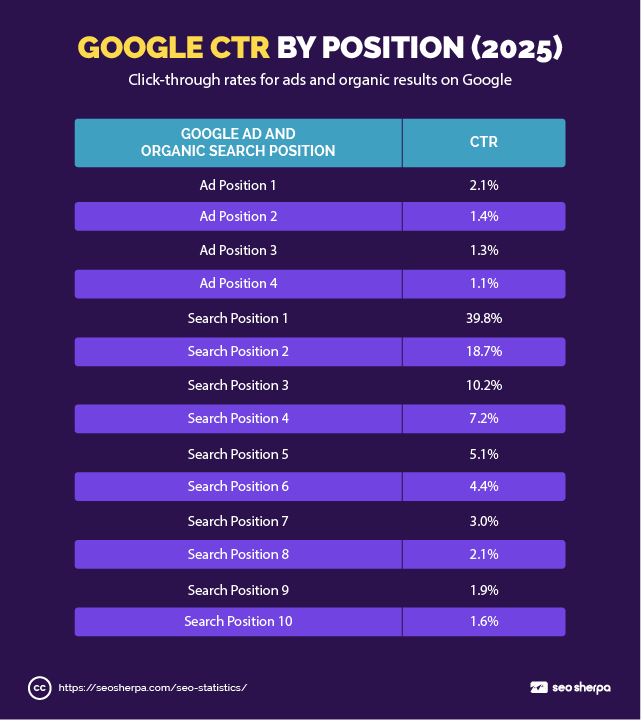
And that matters a lot.
Rather than chasing tiny SEO metrics, improving your ranking position and click-through rate will have the biggest impact on Google search results.
Another reason SEO remains a top focus is the sheer volume of traffic it drives compared to paid ads.
How many people click organic vs. paid search results?
- On one day at the end of 2024, Google’s organic search results got 4.6 billion clicks, while paid ads saw only about 16.4 million clicks(ExplodingTopics).
In other words, organic results dominated with over 99% of clicks, a compelling case for prioritizing SEO to capture search user demand.
Why Keyword Placement Still Impacts SEO Rankings
Almost every top-ranking page includes its target keyword in the title and first heading.
- Backlinko found that nearly 100% of page-one results use their keyword in the title or H1, essentially making it a non-negotiable ranking signal (Backlinko).
In short, include your primary keyword early and naturally, but remember that quality content and user experience still decide who wins.
- Notably, pages in the top 10 today have a 50% lower keyword density than those ranking a couple of years ago (Brightedge).
Google’s algorithms now prioritize information gain and relevance over old-school keyword stuffing.
Meta Tags and SEO: Why They Still Matter in 2025
On-page elements still matter.
- Title tags between 40–60 characters tend to get about 8.9% higher CTR than other lengths, showing the value of concise, keyword-aligned headlines (Backlinko).
Yet many pages still skip the basics:
- About 7.4% of high-ranking pages have no title tag and around 25% lack a meta description (Ahrefs).
In these cases, Google rewrites the snippet, often with mixed results.
Writing solid title tags and meta descriptions is still one of the easiest SEO wins.
How Long-Form Content Boosts SEO and Backlinks
Content length and structure also make a difference.

- The average top-10 Google result is about 1,447 words long, reinforcing that in-depth, long-form content tends to perform better (Backlinko).
These pages typically include multiple sections, subheadings, and bullet points, all signals that help Google understand topic coverage and content depth.
Well-formatted, detailed content paired with focused keywords puts you in the best position to reach page one.
Zero-Click and SERP Features
Zero-Click Searches on Google: What They Mean for SEO
A growing number of Google searches now end without any clicks to external websites.
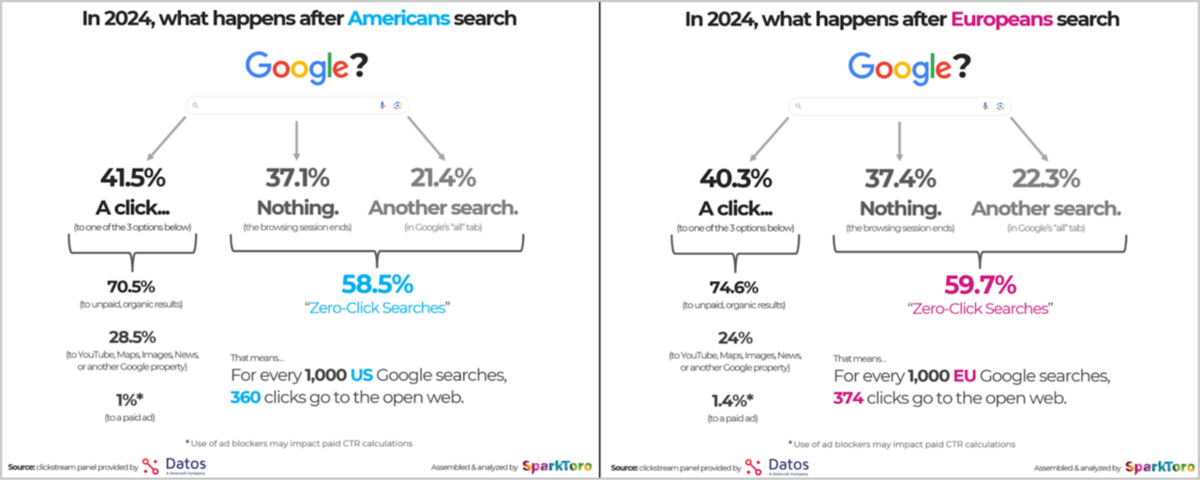
Source:(Sparktoro)
What percentage of searches are zero-click in 2025?
- In 2025, an estimated 58-60% of Google searches are “zero-click”, meaning users get the answer directly from the SERP (Sparktoro).
- Roughly 61.5% of desktop Google searches and 34.4% of mobile searches now result in no click (Sparktoro).
Internet users often find what they need directly on the SERP, via featured snippets, knowledge panels, or AI summaries, so traditional CTR is falling.
The takeaway: Ranking #1 alone no longer guarantees traffic. You need to win those SERP features, too.
How Featured Snippets, PAA, and AI Overviews Impact SEO Clicks
- People Also Ask boxes, for instance, now appear in about 64.9% of all searches, offering users a Q&A style path to information without additional searches (Semrush).
- Featured snippets show up in roughly 12% of queries, but their presence is declining (My Codeless Website).
- Google cut featured snippets by about 35% between late 2024 and early 2025, mainly due to the rise of AI-powered answers(GSQI).
- By January 2025, Google’s AI Overview boxes were showing in 30% of search results, particularly for broad or problem-solving queries (SearchEngineJournal).
Each of these SERP features, from PAA to AI Overviews, takes attention (and clicks) away from traditional organic listings.
These SERP features heavily influence where users click, and whether they click at all.
- Featured snippets and knowledge panels together can capture 42% of all clicks on a search results page, pulling traffic away from traditional links (My Codeless Website).
The strategic takeaway is to optimize for all parts of the SERP, not just blue links.
Structure your content so answers are easy to extract. Use bullet lists, Q&A formatting, and tight summaries.
Use schema markup to help search engines highlight key details like reviews, product specs, and how-tos.
We call this Search Everywhere Optimization, and it’s your best shot at showing up where people actually look.
Mobile & Voice Search Stats
Is Mobile SEO Still Critical In 2025?
The latest mobile SEO statistics show that mobile is still critical in 2025.
- Google searches on mobile now far exceed desktop, globally, around 59% of all internet traffic comes from mobile devices (Statista).

Source: Statcounter
- Google’s index has been mobile-first for years, and for good reason: Google accounts for 93% of mobile searches worldwide (StatCounter).
- In fact, 96% of internet users (nearly 5 billion people) now access the web via a mobile device(StatusLabs).
The implication is clear: If your site isn’t mobile-friendly, you’re effectively invisible to a huge portion of your audience.
Mobile optimization correlates strongly with higher search visibility.
- A full 80% of top-ranking websites are mobile-optimized (StatusLabs).
Site speed and usability on phones are especially crucial – yet significantly less than half of all sites meet Google’s Core Web Vitals standards on mobile.
- Only about 43.4% of websites pass all three Core Web Vitals on mobile devices, meaning the majority of sites still deliver a subpar mobile experience(Debugear).
This is a glaring opportunity.
By improving your mobile page load times (for example, Largest Contentful Paint under the recommended 2.5s) and interactivity, you stand to leapfrog slower competitors.
Google does use these metrics as a lightweight ranking factor, but more importantly, a faster, smoother mobile site keeps users engaged, which indirectly boosts your rankings and conversions.
Voice Search SEO Trends and Stats for 2025
Voice search usage is also rising, changing how people find information.
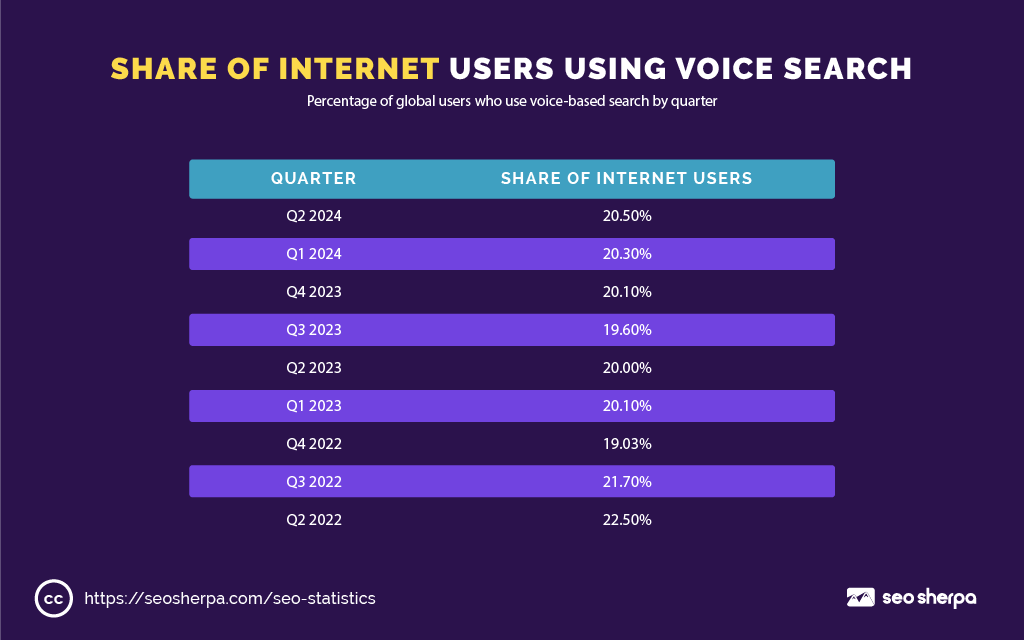
- Over 1 billion voice searches are performed each month, and about 20% of people worldwide use voice search regularly, while 27% use it on mobile (Demandsage).
- In surveys, 90% of consumers report that voice queries are easier and faster than typing, which helps explain why voice assistants like Siri, Alexa, and Google Assistant have become fixtures in many homes (OuterBoxDesign).
People are comfortable asking spoken questions like “Where’s the nearest open pharmacy?” or “What are the best running shoes under $100?” and getting immediate answers.
However, businesses have been slow to optimize for this shift.
- Only 13% of marketers include voice search optimization in their SEO strategy so far(Hubspot).
- This lag comes despite the fact that 41% of American adults use voice search every day, often for local searches and quick-answer queries (ExplodingTopics).
- Over one-third of U.S. consumers now own a smart speaker device, which means there’s a growing opportunity for brands that tailor content to voice queries (edisonresearch).
For instance, incorporating more natural language Q&A content and targeting long-tail, conversational keywords.
In 2025, mobile and voice go hand in hand.
Optimizing for mobile means thinking about how users speak their queries, and ensuring your content can be easily consumed (and answered) on the go or via voice assistant.
Mobile isn’t just critical. It’s foundational, and voice is its fast-growing sidekick.
SEO Trends Backed by Data
Staying ahead in SEO means focusing on real data, not predictions.
A few years ago, experts claimed generative AI would replace search. But reality says otherwise.

Source:Sparktoro
- Google Search received 373X more queries than ChatGPT in 2024 (Sparktoro)
- 98.1% of ChatGPT users use Google (WriteSonic).
The same hype surrounded voice search.
- Some predicted half of all searches would be voice-based by 2020, yet the actual share remains closer to 20% today. (Demandsage)
The lesson: Trends don’t always materialize, but data doesn’t lie.
In 2025, smart SEOs are betting on content quality, speed, technical SEO, and UX, not fads.
How Structured Data Improves Search Visibility
Structured data is no longer optional. It’s standard practice among top performers.
- Seventy-two percent of first-page results use schema markup, making their listings eligible for rich results like review stars, FAQs, prices, or event details (Backlinkio).
- Still, 23% of websites have no structured data at all, missing out on SERP enhancements, among those that do, the most common formats are Open Graph (67.7%) and, JSON-LD (49.7%) (W3Techs).
Even though schema won’t directly boost your rank, it increases visibility and click-throughs by making your snippets stand out.
Core Web Vitals & Performance Still Matter
User experience continues to be a ranking factor, and most sites are still falling short.
Google recommends LCP < 2.5s, INP < 200ms, and CLS < 0.1, yet many sites lag behind.
- Only 33% of websites passed all CWV thresholds in 2022 (Ahrefs).
Fast, stable sites don’t just rank higher; they reduce bounce rates and increase engagement, indirectly boosting SEO performance.
- Pages that met Core Web Vitals saw a 24% drop in bounce rates (Google) .
- Nearly 8 in 10 users say they’re more likely to return to or share a mobile site that’s user-friendly (Google).
Want a competitive edge?
Improve mobile load times, interaction latency, and layout shifts.
That’s what Google’s watching.
How SEOs Are Using AI Tools in 2025
AI-generated content is already shaping the SERP.
- Thirteen percent of top-ranking articles are AI-written, while roughly 19% of Google’s search results now include AI-generated content (Originality).
SEO professionals are rapidly adopting AI and automation to streamline their workflows.
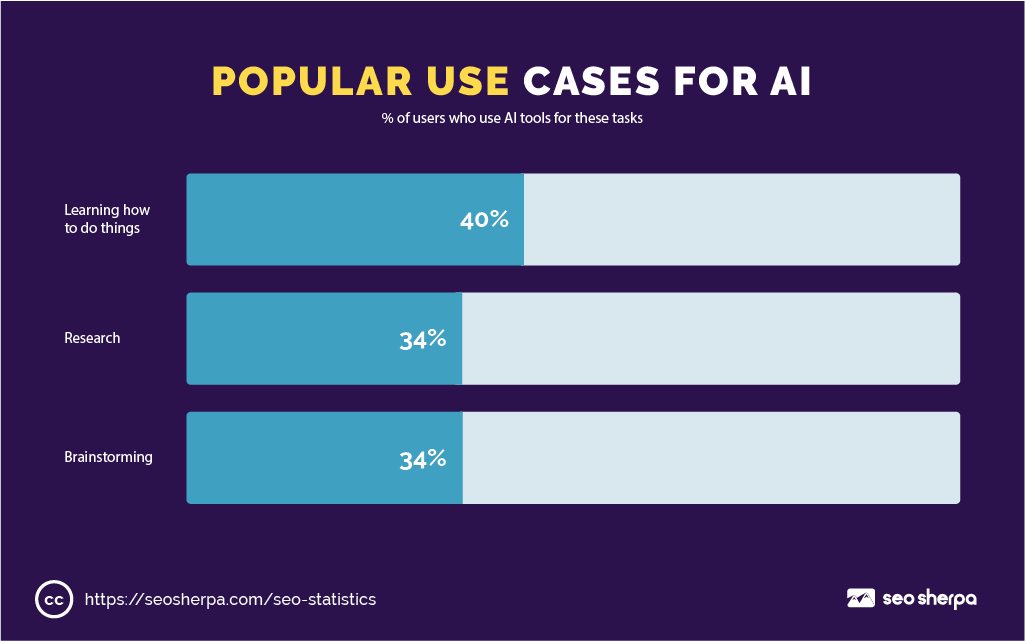
- Eighty-six percent of SEOs have already integrated AI into their processes, using tools for content optimization, keyword research, and technical audits (Hubspot).
- More than half of marketers say they now use AI to help optimize content, including long-form blog posts and copywriting (SurveyMonkey).
And it’s paying off.
- Nearly 65% of companies report better SEO outcomes after bringing AI tools into their stack (Semrush).
- However, 86% of marketers still insist on editing AI-generated text, reinforcing that human oversight remains critical (Hubspot).
Whether it’s machine learning for log file analysis or using AI to draft content faster, the trend is clear: Automation is helping SEOs move faster without cutting corners.
In 2025, the competitive edge goes to those who use AI to enhance, not replace, smart strategy and creative thinking.
Backlinks & Content Statistics
Do Backlinks Still Matter for SEO in 2025?
Backlinks remain a foundational ranking signal in Google’s algorithm, though their influence is shifting.
- Google representatives have indicated that backlinks are no longer in the top three ranking factors (Search Engine Land).
Content quality and user experience now weigh more heavily Still, the correlation between links and rankings is hard to ignore.
- Pages that rank #1 on Google have 3.8X more backlinks than those in positions 2–10, and about 3.2X more referring domains (Banklinkio).
In simple terms, top-ranking pages tend to have stronger backlink profiles, proving that earning authoritative links still provides a major edge in search.
Quality Over Quantity in 2025
SEOs haven’t stopped building links. Far from it.
- Nearly 80% of SEO professionals say link building is a key part of their strategy, while 78% report a satisfying ROI from their campaigns (Authority Hacker).
That said, Google’s webspam team continues to devalue low-effort tactics, so the focus has shifted.
In 2025, the priority is quality over volume.
A handful of links from relevant, trusted sites beats dozens of low-value directory links.
- Survey data backs this up: 60%+ of marketers say inbound strategies like SEO and content generate their highest-quality leads (Statista).
Backlinks still matter, but how you earn them matters more.
Think relationship-driven PR and high-value content, not spammy outreach blasts.
How High-Quality Content Drives Backlinks and Rankings
Content and backlinks go hand in hand, and the numbers prove it.
- Websites with an active blog earn 97% more inbound links on average than those without fresh content (Hubspot).
Long-form content is especially effective.
- Articles with over 2,000 words generate 77% more backlinks than shorter ones, and also tend to rank for more long-tail keywords (Stratabeat).
- Those long-tail queries drive around 70% of all search traffic, so covering broad topics in-depth not only attracts links, it boosts visibility, too (Embryo).
- It’s no surprise that 72% of marketers say publishing high-quality content is their most effective SEO tactic(OptinMonster).
The takeaway: Create deep, useful resources that meet user intent, and let the backlinks (and rankings) follow naturally.
Local SEO Statistics & E-commerce SEO Stats
Why Local SEO Matters for High-Intent Searches in 2025
Local search is a massive part of Google’s ecosystem, and it’s only growing.
- Approximately 46% of all Google searches have local intent (SEOTribunal).
Think of local search queries like “restaurants near me” or “plumber in [city].”
- In the U.S. alone, there are over 5.9 million “near me” keywords, generating around 800 million searches per month. Also eighty percent of U.S. consumers search for local businesses weekly. while 32% do so daily (Soci).
These numbers speak for themselves: Local SEO is essential, especially for brick-and-mortar businesses.
Google’s Local 3-Pack: Why It’s Crucial for Local SEO
Visibility in Google’s local 3-pack can make or break a local business.
- About 42% of searchers click on a result inside the local pack (Backlinko).
If you’re not in that top-3 map block, you’re potentially missing nearly half your audience.
- And the payoff is huge: Businesses in the local 3-pack get 126% more traffic and,
- 93% more actions (calls, directions, clicks) than those ranked just outside it (positions 4–10) (Soci).
But here’s the problem:
- Only 64% of businesses have verified and claimed their Google Business Profile (BirdEye) that leaves over one-third missing out on the most basic local SEO opportunity.
By optimizing your GBP, maintaining consistent NAP data, earning reviews, and publishing local content, you unlock serious visibility and engagement.
E-commerce SEO Growth and Mobile Trends in 2025
E-commerce SEO continues to be a high-growth opportunity.
- By 2027, online shopping is projected to make up 41% of global retail sales, that’s nearly 130% higher than in 2017 (BCG) .
Mobile commerce is driving this growth:
- Smartphones now account for 77% of retail website visits and, about 68% of online orders (Statista).
If your store isn’t mobile-optimized, fast, responsive, and friction-free, you’re losing sales at every touchpoint.
How Product Schema and Ratings Improve Click-Through Rates
Search enhancements can directly improve performance.
Product pages with review stars and schema markup often stand out in the SERP.
- In fact, search results with star ratings get up to 35% higher CTR than those without.(Speero).
Schema doesn’t just make your listing prettier; it makes it more clickable.
And local e-commerce matters, too.
- Eighty-one percent of consumers use Google to evaluate local businesses, including reviews, business hours, and contact info (BrightLocal).
Those reviews directly influence both clicks and conversions.
Whether you’re running a local service or a global store, your goal is the same: Help searchers find trusted, information-rich listings, and make it easy for them to buy.
Key Takeaways & What to Do Next
Use these insights to turn raw data into smarter SEO decisions:
- Start with real numbers. The best strategies aren’t built on hunches. They’re built on testing, tracking, and tweaking. Use these benchmarks to guide your decisions, not guesswork.
- Align your content with real search behaviour. Don’t just think about keywords, think about intent. What are people actually searching for? Use our Keyword Generator to surface high-impact queries you can rank for now.
- Fix the basics before chasing trends. Fast-loading, mobile-first, technically sound pages still win. Nail the fundamentals like Core Web Vitals, clean URLs, and mobile usability.
- Optimize your titles, H1s, and metadata. These aren’t optional. They’re entry-level signals Google still relies on to rank and display your content. Get them right.
Go deep with your content. Long-form, well-structured pages that actually solve problems tend to earn more links, cover more keywords, and climb higher. That’s what Google wants, and what users stick around for. - Earn links through value. Forget spammy outreach. Create resources people want to reference. Think tools, original research, how-tos, and guides.
- Use structured data to boost visibility. Add Product, Review, and FAQ schema so your content stands out in search.
- Optimize for the whole SERP, not just blue links. This is Search Everywhere Optimization in action: Win featured snippets, local packs, PAA boxes, and even AI Overviews. Format your content for skimmability and clarity so it’s easy for search engines to extract.
- Make mobile your baseline. Most traffic is mobile. If your site’s slow or clunky on phones, you’re invisible. Prioritise speed, usability, and mobile-first design.
- Track every change. Update. Measure. Repeat. If something doesn’t move the needle, don’t guess, dig into the “why” and iterate with purpose.
- Use the right tools to move faster. From AI writing assistants to technical SEO audits, tools help scale your efforts. But human strategy still drives results.
- Audit where you stand. Run your site through our Website SEO Grader. It’ll flag what’s holding you back, whether it’s speed, structure, or missing metadata.
- Stay adaptive. The SERP is evolving fast. Voice, AI, mobile, zero-click—these shifts aren’t coming. They’re here. Keep your strategy flexible, grounded in data, and focused on what users actually need.
Wrapping Up: Key SEO Insights from 2025’s Data
The SEO landscape is shifting fast, but the fundamentals haven’t changed.
Focus on content that answers real questions, pages that load fast on mobile, and structure that search engines can understand.
Use these stats as your guide.
And if you’re ready to fix what’s holding your site back, download our [Technical SEO Checklist]. It’s packed with quick wins that boost rankings fast.

Now go optimize with confidence.

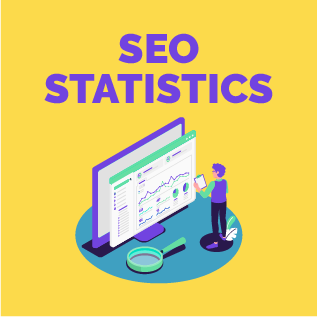










Leave a Reply